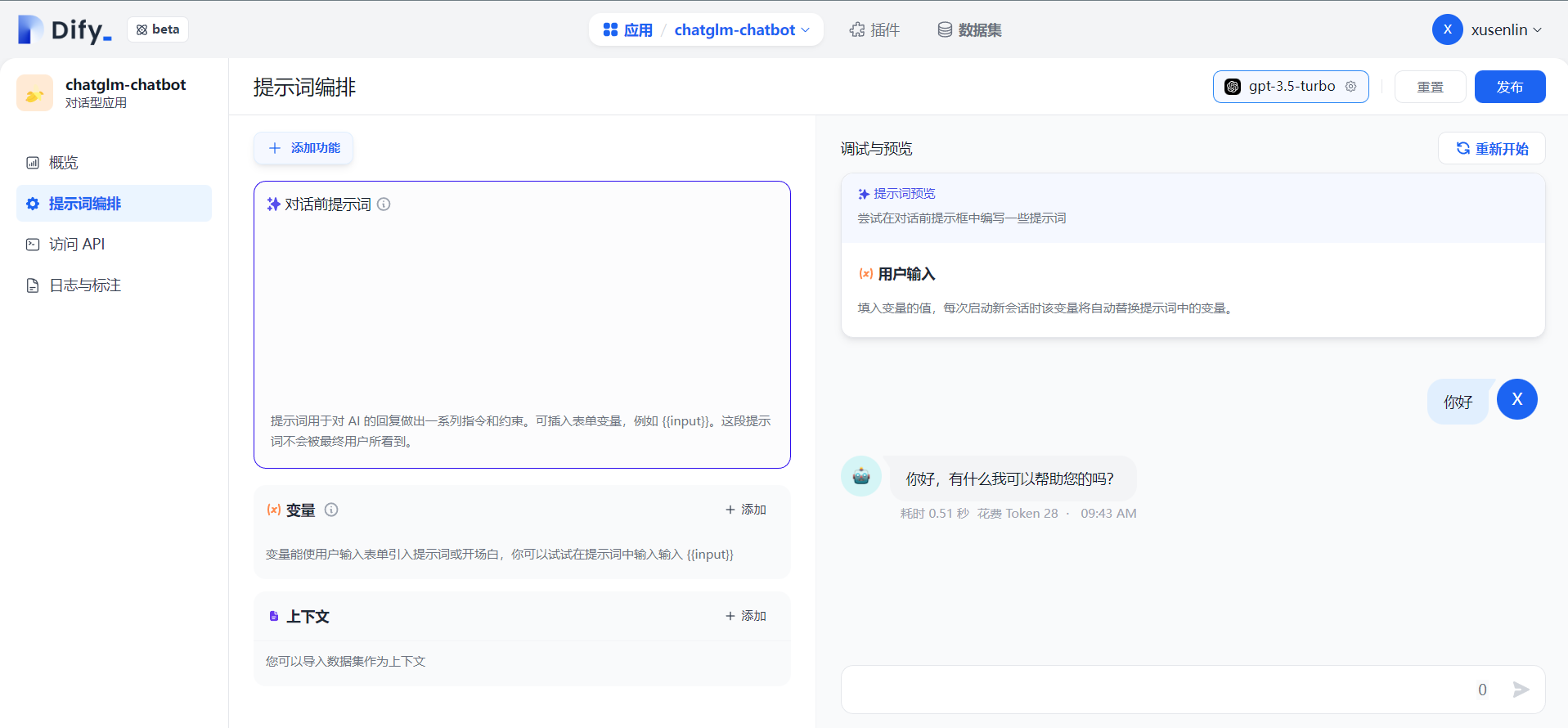API for Open LLMs
📢 News
-
【2023.08.04】 增加通义千问模型工具调用示例,支持
function call特性,调用方式参考 邮件发送助手、定积分计算器、SQL查询 -
【2023.08.03】 支持 qwen-7b-chat 模型,启动方式见 qwen-7b-chat
-
【2023.07.14】 支持在一个
API BASE下调用多个模型 -
【2023.07.12】 支持 baichuan-13b-chat 模型,启动方式见 baichuan-13b-chat
-
【2023.07.07】 支持 InternLM 模型,启动方式见 internlm-chat-7b
-
【2023.06.26】 支持 ChatGLM2-6b 模型
-
【2023.06.12】 使用 m3e 中文嵌入模型(在中文文本分类和文本检索上都优于
openai-ada-002)
主要特性:
此项目为开源大模型的推理实现统一的后端接口,与 OpenAI 的响应保持一致,具有以下特性:
-
✨ 以
OpenAI ChatGPT API的方式调用各类开源大模型 -
🖨️ 支持流式响应,实现打印机效果
-
📖 实现文本嵌入模型,为文档知识问答提供支持
-
🦜️ 支持大规模语言模型开发工具
langchain的各类功能 -
🙌 只需要简单的修改环境变量即可将开源模型作为
chatgpt的替代模型,为各类应用提供后端支持 -
🚀 支持加载经过自行训练过的
lora模型
🐼 模型
支持多种开源大模型
| Model | Backbone | #Params | Claimed language | checkpoint link |
|---|---|---|---|---|
| qwen-7b-chat | Qwen | 7B | en, zh | Qwen/Qwen-7B-Chat |
| baichuan-13b-chat | Baichuan | 13B | en, zh | baichuan-inc/Baichuan-13B-Chat |
| InternLM | InternLM | 7B | en, zh | internlm/internlm-chat-7b |
| ChatGLM2 | GLM | 6/130B | en, zh | THUDM/chatglm2-6b |
| baichaun-7b | Baichuan | 7B | en, zh | baichuan-inc/baichuan-7B |
| Guanaco | LLaMA | 7/33/65B | en | timdettmers/guanaco-33b-merged |
| YuLan-Chat | LLaMA | 13/65B | en, zh | RUCAIBox/YuLan-Chat-13b-delta |
| TigerBot | BLOOMZ | 7/180B | en, zh | TigerResearch/tigerbot-7b-sft |
| OpenBuddy | LLaMA、Falcon | 7B | multi | OpenBuddy |
| MOSS | CodeGen | 16B | en, zh | fnlp/moss-moon-003-sft-int4 |
| Phoenix | BLOOMZ | 7B | multi | FreedomIntelligence/phoenix-inst-chat-7b |
| BAIZE | LLaMA | 7/13/30B | en | project-baize/baize-lora-7B |
| Chinese-LLaMA-Alpaca | LLaMA | 7/13B | en, zh | ziqingyang/chinese-alpaca-plus-lora-7b |
| BELLE | BLOOMZ | 7B | zh | BelleGroup/BELLE-7B-2M |
| ChatGLM | GLM | 6B | en, zh | THUDM/chatglm-6b |
🐳 环境配置
docker启动(推荐)
构建镜像
docker build -t llm-api:pytorch .启动容器
docker run -it -d --gpus all --ipc=host --net=host -p 80:80 --name=chatglm \
--ulimit memlock=-1 --ulimit stack=67108864 \
-v `pwd`:/workspace \
llm-api:pytorch \
python api/app.py \
--port 80 \
--allow-credentials \
--model_name chatglm \
--model_path THUDM/chatglm-6b \
--embedding_name moka-ai/m3e-base主要参数含义:
-
model_name: 模型名称,如chatglm、phoenix、moss等 -
model_path: 开源大模型的文件所在路径 -
embedding_name(可选项): 嵌入模型的文件所在路径
更多模型的启动命令详见 SCRIPT.md
本地启动
安装 pytorch 环境
conda create -n pytorch python=3.8
conda activate pytorch
conda install pytorch cudatoolkit -c pytorch安装依赖包
pip install -r requirements.txt启动后端
python api/app.py \
--port 80 \
--allow-credentials \
--model_path THUDM/chatglm-6b \
--embedding_name moka-ai/m3e-base🤖 使用方式
环境变量
-
OPENAI_API_KEY: 此处随意填一个字符串即可 -
OPENAI_API_BASE: 后端启动的接口地址,如:http://192.168.0.xx:80/v1
聊天界面
cd applications
python web_demo.pyopenai-python
👉 Chat Completions
import openai
openai.api_base = "http://192.168.0.xx:80/v1"
# Enter any non-empty API key to pass the client library's check.
openai.api_key = "xxx"
# Enter any non-empty model name to pass the client library's check.
completion = openai.ChatCompletion.create(
model="chatglm-6b",
messages=[
{"role": "user", "content": "你好"},
],
stream=False,
)
print(completion.choices[0].message.content)
# 你好👋!我是人工智能助手 ChatGLM-6B,很高兴见到你,欢迎问我任何问题。👉 Completions
import openai
openai.api_base = "http://192.168.0.xx:80/v1"
# Enter any non-empty API key to pass the client library's check.
openai.api_key = "xxx"
# Enter any non-empty model name to pass the client library's check.
completion = openai.Completion.create(prompt="你好", model="chatglm-6b")
print(completion.choices[0].text)
# 你好👋!我是人工智能助手 ChatGLM-6B,很高兴见到你,欢迎问我任何问题。👉 Embeddings
import openai
openai.api_base = "http://192.168.0.xx:80/v1"
# Enter any non-empty API key to pass the client library's check.
openai.api_key = "xxx"
# compute the embedding of the text
embedding = openai.Embedding.create(
input="什么是chatgpt?",
model="text2vec-large-chinese"
)
print(embedding['data'][0]['embedding'])langchain
👉 Chat Completions
import os
os.environ["OPENAI_API_BASE"] = "http://192.168.0.xx:80/v1"
os.environ["OPENAI_API_KEY"] = "xxx"
from langchain.chat_models import ChatOpenAI
from langchain.schema import HumanMessage
chat = ChatOpenAI()
print(chat([HumanMessage(content="你好")]))
# content='你好👋!我是人工智能助手 ChatGLM-6B,很高兴见到你,欢迎问我任何问题。' additional_kwargs={}👉 Completions
import os
os.environ["OPENAI_API_BASE"] = "http://192.168.0.xx:80/v1"
os.environ["OPENAI_API_KEY"] = "xxx"
from langchain.llms import OpenAI
llm = OpenAI()
print(llm("你好"))
# 你好👋!我是人工智能助手 ChatGLM-6B,很高兴见到你,欢迎问我任何问题。👉 Embeddings
import os
os.environ["OPENAI_API_BASE"] = "http://192.168.0.xx:80/v1"
os.environ["OPENAI_API_KEY"] = "xxx"
from langchain.embeddings import OpenAIEmbeddings
embeddings = OpenAIEmbeddings()
query_result = embeddings.embed_query("什么是chatgpt?")
print(query_result)可接入的项目
通过修改上面的 OPENAI_API_BASE 环境变量,大部分的 chatgpt 应用和前后端项目都可以无缝衔接!
docker run -d -p 3000:3000 \
-e OPENAI_API_KEY="sk-xxxx" \
-e BASE_URL="http://192.168.0.xx:80" \
yidadaa/chatgpt-next-web# 在docker-compose.yml中的api和worker服务中添加以下环境变量
OPENAI_API_BASE: http://192.168.0.xx:80/v1
DISABLE_PROVIDER_CONFIG_VALIDATION: 'true'📜 License
此项目为 Apache 2.0 许可证授权,有关详细信息,请参阅 LICENSE 文件。
🚧 References
-
BLOOM: A 176B-Parameter Open-Access Multilingual Language Model
-
Efficient and Effective Text Encoding for Chinese LLaMA and Alpaca
-
MOSS: An open-sourced plugin-augmented conversational language model
-
FastChat: An open platform for training, serving, and evaluating large language model based chatbots
-
LangChain: Building applications with LLMs through composability










